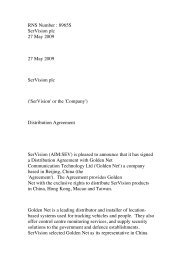TVG-Series System Guide v1-4 - SerVision
TVG-Series System Guide v1-4 - SerVision
TVG-Series System Guide v1-4 - SerVision
You also want an ePaper? Increase the reach of your titles
YUMPU automatically turns print PDFs into web optimized ePapers that Google loves.
<strong>SerVision</strong><br />
<strong>TVG</strong> <strong>System</strong> <strong>Guide</strong><br />
Appendix C: Networks Managed by <strong>SerVision</strong><br />
Routers<br />
MVG and UVG models have built-in <strong>SerVision</strong> routers. Each of these routers manages a small local network<br />
(LAN) that can include up to four devices – the video gateway itself and up to three other devices. For example, you<br />
could connect a PC and an IP-based cash box to the router, and they would all be part of the unit’s local network.<br />
The <strong>SerVision</strong> router makes it possible to connect MVG and UVG units to multiple networks – cable-based,<br />
cellular, and WiFi – at one time.<br />
Because the router is part of both the internal LAN and one or more external networks, it has two types of IP<br />
addresses:<br />
• Local IP: An IP address on the internal LAN. This IP address identifies the router within the network that it<br />
manages. It is static (fixed) and is 172.20.233.1.<br />
• External IP: An IP on each external network to which it is connected (cabled LAN, WiFi, and/or cellular).<br />
These IPs function as the public IP addresses of the <strong>TVG</strong> units themselves, and are assigned by the system<br />
administrators of the relevant networks.<br />
The router contains a DHCP server that can automatically assign IP addresses to devices that are plugged into its<br />
Ethernet ports. If you will not need to access a connected device remotely, you can configure the device to acquire<br />
its IP from this DHCP server. In this case, the device will be able to connect to the external network, but remote<br />
devices will not be able to access it. If you want to access the device remotely, you should manually configure its IP<br />
address and other network settings as described below (for information about how to configure the network settings<br />
of the device, consult the device’s documentation), and set up port forwarding for the device as described under<br />
Port Forwarding, page 52.<br />
NOTE:<br />
The video gateway component of the <strong>TVG</strong> automatically connects to the router component when the<br />
unit starts up. The router's DHCP server assigns an IP address to the video gateway component and<br />
port forwarding is automatically configured.<br />
Setting<br />
Value<br />
IP Address<br />
Assign a static IP address to the device. The IP must be in the range 172.20.233.2 through<br />
172.20.233.99.<br />
Mask 255.255.255.0<br />
Gateway 172.20.233.1<br />
DNS 172.20.233.1<br />
Appendix C: Networks Managed by <strong>SerVision</strong> Routers 201





